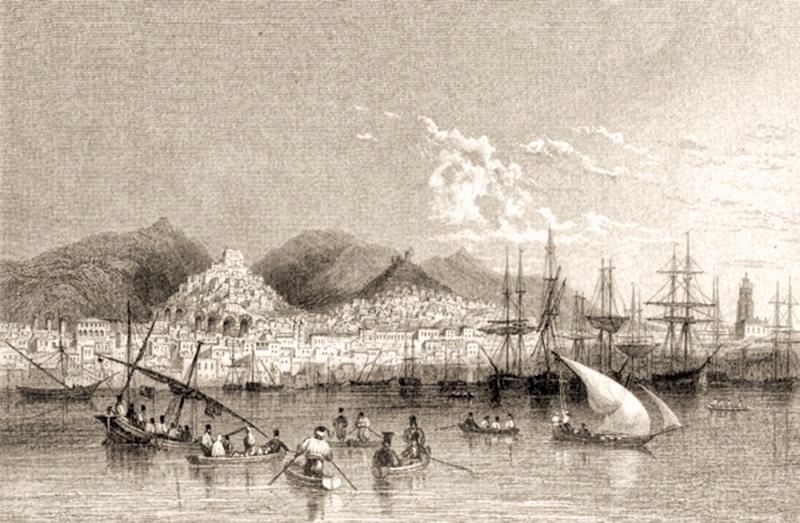The name Syra, instead of Syros is recorded for the first time in a work by Isichiou of Milisiou (6th c. B.C). The island was named Souda under Prankish rule.
During its decline it was pejoratively called Psyra according to the folksy saying: “Syra psyra – Mykono kasida” (“Syros lice – Mykonos lice eggs”).

Homer sang of “two-citied Syros” (the principal settlements were in today’s Vari and Apano Meria). The, so-called, blind poet “saw” and praised the island’s beauty and agricultural bounty: “…plant-filled, full of apples, plenty of wine, many-seeded”.
2800-2300/2200 B.C.:
the island was originally inhabited, most probably, by the Kares or the Leleges. Research by the archaeologist X. Tsountas in the northeast part of the island (Chalandriani – Kastri) has shed much light on the prehistoric period.
Significant finds in this region include many graves with their burial goods, ceramic vessels, stone compasses, statuettes, intact skeletons and ancient ruins, the remains of former Acropolis (fortified hill-top site) and Pyrgos (watch-tower).
5thc. B.C.: the Phonecians arrived on the island. They might have named it Syros from the Phoenician word Sour. Next, under the leadership of Ippomedonta, the lonians held sway. According to Homer, the ruler during this period was Ktisias.
6th c. B.C.: Pythagoras’ teacher, the renowned philosopher Ferekidis, was born and reached his acme on Syros.
During the reign of Polycraty on Samos, Syros fell into the hands of the Samions; Killikon, the Syrian traitor ‘lent his hand’ in the betrayal.
During the Persian wars the island was conquered by the Persians and subsequently, ‘liberated’ by the Athenians who, although they did grant independence, levied their taxes from the island.
4th c. B.C.: subjected to the rule of Phillip of Macedonia.
1st c. B.C.: Syros during the Roman era enjoyed the acme of civilization for about two centuries; then a severe decline followed. The island was always ‘overshadowed’ by its neighbor, Sacred Delos.
Christian – Byzantine era:
Early Byzantine period: Syros was… unknown, cloaked by invisibility. Meanwhile the gods and their demigods, Poseidon, Asphalios, Athena, Amphitriti, Panas, Dimitra, the Kaveiroi, Dionysus, Apollo, Hermes, relinquished their places to Christ and His Church. Syros originally came under the j ecclesiastical provenance of the Bishopric of Delos, and later, of the Mitropoly of Athens.
7th -8th c. A.D.: raids by Arab pirates. The results: catastrophe and the great plague (747-750).
Venetian rule – Ottoman rule
1207: Marcos Sanoudos I conquered Syros as well as Naxos (the Duchy of the Aegean).
1286: The siege of the …donkey…
” Back then, pirates seized ‘the finest donkey’ from Tinos, where Bartholomaios Gkizis ruled, and sold her to the ruler of Syros, Guiliemo Sanoudo, son of Marcos Sanoudo II. The donkey bore the brand of its owner and so its noble buyer was i considered a receiver of stolen goods. Bartholomaios Gizis used this as an excuse to undertake an aggressive military campaign against Syros, besieging and nearly capturing the island’s Kastro.
At that time the fleet of Carolos Andegano II, the King of Naples, happened to be in the Aegean and came to Syros’ aid. Gkizi was forced to lift the siege and take back his donkey, which had cost, so far, thirty thousand weight in ‘soldes’ and eighteen thousand gold ducats (don’t bother to convert it into Euros)…”
1383: the Duke of Naxos included Syros in the dowry of his daughter Petronella.
Early 15th c.: The extreme poverty on the island forced the inhabitants to assuage their hunger with carob pods.
1537-1564: Syros changed conquerors once again: this time the island was overrun by the Ottoman Turks. Although subjected to the Sultan during Ottoman rule, Syros was self-governing and maintained a favored status; at the same time, the Duke of the Aegean was the Spanish Jew, Yosif Nazi. Certainly, the island was under Ottoman occupation, but the Cadiz was the lone Turk on the island.
1580: The Sultan Mourat III grants a ‘thelim’ to the people of Syros giving them especially favored status.
1617: All Tselepi Kapodan Pasha scourged the island with raids, burning the town, the churches and hanging the Catholic bishop, lo. Andrea Karga.
1770-1774: during the first Russo-Turkish war, Syros was taken over for a period of three years by the Russians, who robbed the island completely and then, once again, it fell to the Turks.
1779-1803: The Sultan Abdul Hamit gave the island to his niece Sakh as a dowry, after first bestowing on her the severed head of her predecessor the Bey!
During the revolution of 1821, under French protection, the island, althoug’-not actively mobilized in the struggle for Liberation, was valuable for its participation in another aspect of the war: it became the refuge for persecutec Greeks, fleeing from every corner of their struggling land. This wave of immigrants became established chiefly in Kato Syros, in the area of the ‘limiona’ (harbor-haven), where they created the miracle of the 19th century: the commercial capital of Greece, Hermoupolis.
